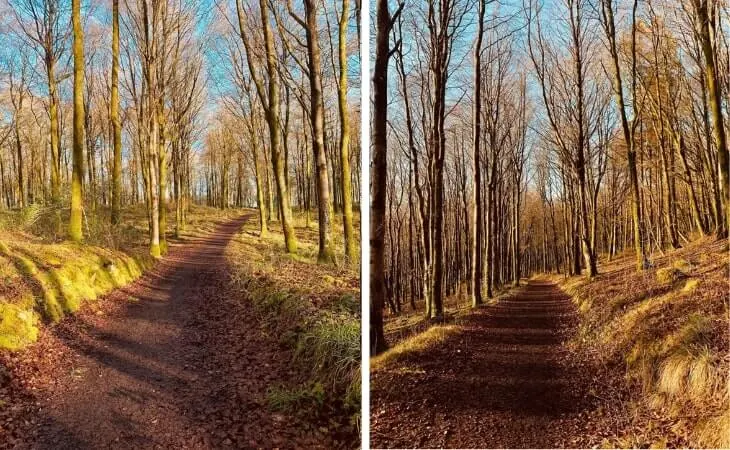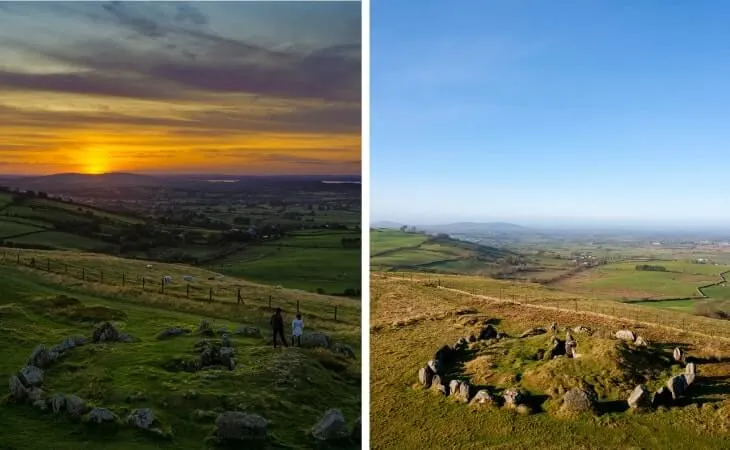If you’re looking for worthwhile things to do in Westmeath, the Mullaghmeen Forest walk is well worth a crack.
This beautiful beech forest, the largest planted in Ireland, is nestled in between farmland to the north of Westmeath, a stone’s throw from both Meath and Cavan.
With four hundred hectares of forest, you’ll discover a variety of other native trees and magnificent views across Lough Sheelin as you ramble your way along the Summit or Red trails.
Some quick need-to-know about Mullaghmeen Forest

Photos with thanks to @grianghraifdeirinn
Although a visit to Mullaghmeen Forest is fairly straightforward, there are a few need-to-knows that’ll make your visit that bit more enjoyable.
1. Location
Mullaghmeen Forest is located in the north of Westmeath. It’s a 10-minute drive from Loughcrew (Meath), a 20-minute drive from Ballyjamesduff (Cavan) and a 30-minute drive from Kells (Meath).
2. Parking
There is ample parking (here on Google maps) at Mullaghmeen Forest and, at the weekends, a small takeaway cafe-van is present in the car park. Do note, there are no other amenities on-site.
3. Four trails to tackle
Using standard trail marking colours, Mullaghmeen Forest has 4 trails for you to select and navigate with the available map. The Yellow Loop; 1.4kms, Red Loop; 3.5kms, Blue Loop; 4.4kms, and the White Loop; 8kms. Each is unique with historic and interesting landscape features and occasionally intersects with the others.
The Mullaghmeen Forest walks

Map via Coillte
Located approximately 8 kilometres west of Oldcastle, County Meath, you’ll find this isolated 1000 acre patch of raised forest in Westmeath.
The forest is made up of the largest planted beech forest in Ireland and is also filled with Sitka spruce, Scots pines, and noble fir trees, along with other native trees.
The forest once belonged to Lord Gradwell and was farmed through much of its history.
Before Lord Gradwell, it had formerly been a part of the estate belonging to Lord Buckingham.
But, in the 1930s the land was acquired by the Department of Agriculture and planted with imported deciduous trees from Norway, Sweden and Germany.
1. Mullaghmeen Pink Multi-Access Trail
Waymarked as ‘Pink’, this trail is considered to be of a low-difficulty and is accessible for all. The trail takes approximately 15-minutes to cover and is a maximum of 0.2km long in a linear pathway.
The trail sets out from, and returns to, the Mullaghmeen Forest Car Park, and slowly meanders through lovely woodland before completing a u-turn to wander back on.
It’s ideal for those with mobility issues or those who have time limitations but want to enjoy the forest.
- Time: 15 minutes
- Length: 0.2kms
- Difficulty: Multi-access
- Start-point: Mullaghmeen Forest Car Park
2. Mullaghmeen Yellow Walk
Slightly more challenging, the Yellow Loop is 1.5kms long and is considered to be ‘moderate’ in grading. The Loop will take an average of 50-minutes, and starts and ends in the Mullaghmeen Forest car park.
The Yellow Loop makes its way up and down through the lightly wooded forest and is the perfect spot for a dose of tree bathing. At any point during the year, this section of the forest is particularly beautiful, especially in the middle of autumn when the leaves turn and fall, or in springtime with the display of woodland flowers, in particular the bluebells.
- Time: 50 minutes
- Length: 1.5kms
- Difficulty: Moderate
- Start-point: Mullaghmeen Forest Car Park
3. Mullaghmeen White Walk
Starting from the car park’s entrance near Hammondstown, it loops through the beech forest and passes the remains of famine fields, and a famine garden.
In the spring, there is a wonderful display of woodland flowers, and there are scenic views out across Lough Sheelin and towards County Cavan. This is the longest of the walks and is best suited to those who are used to walking distances.
- Time: 2 hours
- Length: 8kms
- Difficulty: Moderate
- Start-point: Mullaghmeen Forest Car Park
4. Mullaghmeen Red Walk
A shorter Loop-style walk, this trail leads its hikers up and down several gentle hills and returns to the car park. It is considered to be easy in nature and can be taken at a leisurely pace to best enjoy the surrounding beauty of the forest.
The loop will also take the walker through large areas of beech, which are a riot of colour in the autumn, and in the springtime when the woodland flowers are on display – especially the carpet of bluebells that nestle amongst the beeches.
- Time: 1 hour and 20-minutes
- Length: 3kms
- Difficulty: Easy
- Start-point: Mullaghmeen Forest Car Park
5. Mullaghmeen Blue Walk
This loop extends itself up through the beech forest and a cairn from which point you can enjoy views towards Lough Sheelin and County Cavan. The walk is better suited to those who are fit and used to navigating varying terrains.
The blue trail is a scenic route, which also takes in the summer grazing shelter known as a Booley Hut, the flax pits, and famine fields and garden before returning through a forest of native species.
- Time: 1 hour and 45-minutes
- Length: 4.5kms
- Difficulty: Moderate
- Start-point: Mullaghmeen Forest Car Park
Things to do nearby
One of the beauties of Mullaghmeen Forest is that it’s a short spin away from many of the best places to visit in Meath and Westmeath.
Below, you’ll find a handful of things to see and do a stone’s throw from Mullaghmeen Forest.
1. Loughcrew Cairns (15-minute drive)

Photos via Shutterstock
Due east, Loughcrew Cairns are a site of Neolithic burial chambers that date back to 3300 BCE. They contain stone carvings, impressive rock paintings and are aligned to the sunrise on the equinoxes. Cairn T, the largest cairn, is well worth visiting, although it is only accessible on foot and up a slight incline.
2. Fore Abbey (20-minute drive)

Photo by Eva Kmetty on Shutterstock
To the south of Mullaghmeen Forest is Fore Abbey, and is home to the monastery that was founded by Saint Feichin in the seventh century. The site contains the ruins of a church that dates back to 900 AD, and to 18 Fore crosses that are spread across 10 kilometres of nearby roads and fields.
3. Lough Sheelin (20-minute drive)

North of the forest is Lough Sheelin and its trout-filled waters. Popular amongst anglers and bird watchers alike, the Lough is picturesque at both sunrise and sunset. There are areas of pebbled ‘beach’, and also nearby woodland. A small boat launch is also available for on-water access.
4. Deerpark Forest Park (25-minute drive)

Situated just north of Lough Ramor, Deerpark Forest Park is 160 hectares of woodland and a haven for walkers and wildlife alike. With trails that meander through the forest, or by the river’s edge, the park is ideal for escaping the 21st century and enjoying peace and quiet.
